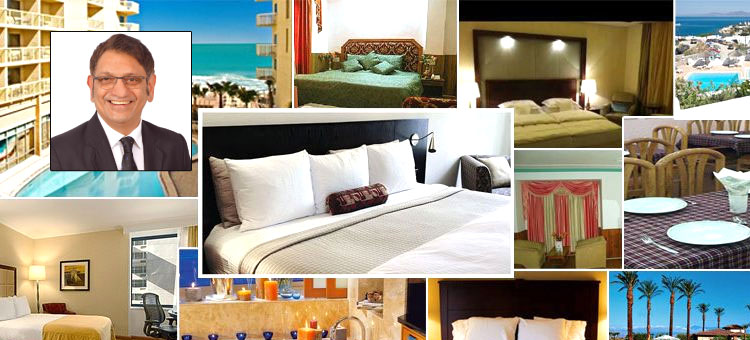In the June 2018 issue of this magazine, when I had written about the big opportunity in the mid-market and economy hospitality segment, I had briefly touched upon the excess capacity in the luxury and premium category of hotels in India. In this edition, I will further elaborate on the deep mess investors invited upon themselves with blind optimism by building too many five-star and four-star hotels in the last one and a half decades, and if the grim reality today poses any silver linings at all.
Currently, there are over 200 stressed hotel assets in India, of which, 80 per cent are in the luxury/premium category. Stressed loans have jumped over 63 per cent in the last three years in this sector. According to Prognosis Global Consulting, of the total lending exposure of Rs. 40,500 crore, 23 per cent is under stress – a whopping Rs. 11,000 crore. SBI has already confirmed that they are not taking any fresh big-ticket exposure in the hotel and tourism sector.
Luxury/premium hotels are in a fix with no way out of the quagmire. Real estate is exorbitantly priced. Capacity exceeds supply. Room rates have plummeted. And loans are turning in to a Damocle’s Sword. The Leela Mumbai and Trident Hyderabad are sad examples of this sorry state of affairs.
From the 1960s to 2011, the Indian hotel industry was growing in the luxury and premium segment, looking primarily at FTAs. Metro cities saw five-star and four-star hotels coming up dime a dozen. In 1991, the liberalisation of the Indian economy threw open a world of new opportunities. Suddenly, the hotel industry started being viewed as integral to the infrastructure necessary for creating a new corporate India.
Currently, there are over 200 stressed hotel assets in India, of which, 80 per cent are in the luxury and premium category. But is there a silver lining?
Business tourism especially from the Western world post liberalisation contributed to the stupendous growth of the Indian hospitality industry. Gateway cities in India saw huge traffic, including Bengaluru, thanks to the IT boom. In fact, luxury hospitality in the business segment grew more than in the leisure space. Strong currency markets like the US and UK could easily afford luxury hotels for their staff travelling to India to manage projects in recently opened up sectors.
The herd mentality in sector-specific investments resulted in everyone dabbling in Indian hospitality. The high share price of IHCL (Taj) and EIHL (Oberoi) then, also made the hotel industry attractive to new investors. Till 2001, the dream run continued when FTAs declined suddenly post 09/11. This is where India’s domestic tourism market buoyed by middle class affluence, thanks to India’s economic resurgence, changed the course of the hospitality industry’s destiny. India discovered its own market post 09/11 – Goa became a year-round destination; monsoon tourism kicked off; Indian middle class started holidaying in large numbers.
India’s domestic market of 1614 million visits (2016 statistic) is one of the largest in the world. 60-70 per cent of the Indian hospitality sector today depends on domestic market movements. If we were to depend on FTAs to survive, we would have collapsed long ago. We demonstrated that we are self sufficient by rallying together and discovering a domestic market.
During the 17 years (1991 to 2008), ARRs grew year-on-year and peaked, attracting many more investors. Capacity was getting added at a feverish pace, yet the market kept absorbing additional inventory. The year 2008 was a turning point for the hospitality industry worldwide as the global economy collapsed. Indian hospitality industry also bore the brunt. We still have not been able to reset to pre-2008 days.
The domestic demand could not fill the gap left by foreign business travellers post 2008 and the impact was most felt in premium and luxury segment. ARR and occupancy crashed – two key drivers of the hospitality industry P&L – leading to a terrible crisis. All new inventory suffered, especially ones that opened between 2005 and 2008 and later. From 2009 to 2011, they sustained and bled but beyond that, a lot of them decided to sell. In the last seven years, over 200 units have come on the block. Over a 100 are NPAs. From ARR of Rs. 20,000 for five-star luxury in 2007, today one can get a luxury room at Rs. 10,000 in a metro city!
India should learn from Singapore’s hospitality industry. Through careful planning and forecasting of demand and supply, they have grown their capacity as well as ARR and occupancy, ably supported by ever-increasing FTA numbers due to effective destination marketing and investments in unique attractions and experiences.
That India can attract only a small percentage of luxury tourists is a fact. We are going to be a much sought-after mid-market and economy destination in the next decade for foreign tourists but we have to improve our tourism infrastructure, ensure safety and hygiene, and up the game in destination marketing. Indian domestic travel is poised to become a $48-billion industry by 2020 says a new report published by Google India along with Boston Consulting Group (BCG). As per the report, hotels will grow at 13 per cent to $13 billion by 2020.
There is where I see an opportunity. The ailing five-star and four-star hotels on the block offer an excellent ‘value for money’ buy for operators with deep pockets looking at expanding and consolidating fast. Under-dressing and rebadging these as mid-market and economy properties and driving economies of scale in operations can be a sure shot winner.
I will stick my neck out to say that the asset owners (real estate players) of these ailing properties even today have the mindset of builders and not hoteliers. They expect returns as per traditional land appreciation which a new buyer who wants to run the hotel is not willing to pay for. Hence, valuations are on different metrics and sale conversations are not going anywhere. It is time for asset owners to accept their mistake and go in for the much-needed haircut, albeit a painful one. Time lost is value lost forever.
The author is a hospitality industry veteran with over four decades of standing having served in various senior leadership roles with the Taj Group of Hotels. He is the founder director of Turnstone Hospitality and Co-owner of Purple Cloud Hotels & Resorts.






